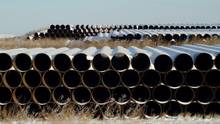In the more than half a decade the Keystone XL pipeline proposal spent in limbo – neither accepted nor rejected, neither pumping nor scrapped – thousands upon thousands of miles of new oil pipeline were built across the United States, without fuss or much public interest. In the years to come, many other pipelines crisscrossing U.S. soil will surely be approved. But Keystone is, or was, different. American politics long ago took hold of it, first putting it into an indefinite deep freeze, and then this week keeping it alive just long enough to finally kill it.
On Monday, the company behind the project, TransCanada Corp., asked the U.S. government to suspend its application. The move made sense, given that it was already apparent that the application had little chance of success under the Obama administration.
But the U.S. State Department, which long ago put the application into suspended animation, refused to agree to the company’s request. Instead, Washington kept its Keystone review alive – the same review it had long refused to finish, until finally announcing on Friday that there will be no State Department approval for the pipeline.
Why did this take so long? Politics. Why did the U.S. kill it now? Politics. A Democratic White House that long hoped to ignore Keystone needed the project to stick around so that it could best cash in when it finally got around to very publicly killing it just before the Paris climate change conference.
For U.S. environmentalists, for voters who lean green, for like-minded political donors and for most of the Democratic Party, this one pipeline – not all pipelines, just this one – was a signifier of where politicians and voters stood and wanted to be seen as standing on climate change. This was, and still is, also true for Keystone’s rabid supporters in the Republican Party.
Of course, Keystone’s cancellation will have zero impact on global warming, something President Barack Obama admitted on Friday. Oil is moving, and the only question is whether it will be moved more safely and efficiently, or less. Pipelines are generally better on both of those counts than the alternatives, such as rail. A policy to reduce the use of fossil fuels was always needed, even as North Americans continued to burn oil – but if the United States ever develops an effective carbon-reduction policy, it will involve taxes on all carbon-using consumers, not the selective demonization of pipelines. That was obvious – and for the fate of Keystone, irrelevant. It long ago crossed from the world of rational cost-benefit analysis into the realm of emotions and symbols.
President Obama will meet Prime Minister Justin Trudeau at the Paris climate change conference next month; they might meet even earlier. Mr. Trudeau, like Mr. Obama, wants to be seen as doing big things to address global warming. But in contrast to his American counterpart, Mr. Trudeau and the Liberals have been in favour of Keystone – and with good reason. Unlike some other proposed pipeline routes, Keystone would not have crossed major mountain ranges, or vast stretches of difficult Canadian territory. It wouldn’t have sent tankers traversing pristine waters. That’s why it made sense for Canada’s oil industry and America’s consumers and oil refiners. U.S. politics, however, got in the way.
It was always convenient to blame Stephen Harper’s government for failing to get Keystone accepted by the White House. American environmentalists long ago came to see Canada’s oil sands as dirty oil; south of the border, they are always referred to as “the tar sands.” The lack of any significant progress on greenhouse-gas reduction during the decade of the Harper government didn’t helpthat image.
But blaming Mr. Harper wasn’t really fair. Canada’s ability to influence the U.S. political process is limited. Canada’s new prime minister, Justin Trudeau, and his government should plan accordingly.
When they meet, Mr. Trudeau should again express regret to Mr. Obama over the rejection of Keystone, as he did on Friday. But he must do so while privately conceding that, given the realities of U.S. politics, not to mention the power imbalance between the two countries, he has little chance of making headway.
But there are still major steps the Trudeau government can take to improve Canada’s ability to move oil, while also improving the country’s ability to fight global warming. Conveniently, the new government has promised to do both.
On global warming, the Trudeau government has not put forward a clear plan of exactly how it will substantially reduce Canada’s greenhouse-gas emissions. But it has said it will work with the provinces to come up with national targets, and that the new government is in favour of putting a price on carbon, through cap-and-trade or carbon taxes. That’s a stark contrast to the previous government’s position. Mr. Trudeau is travelling with the provincial premiers to the Paris climate talks starting at the end of this month to get the ball rolling.
And yet even if Canada had had a better record on global warming, or a better marketing plan with U.S. voters, it wouldn’t have made much of a difference. American politics is self-directed and inward-looking; Canadian energy policy should never be built on the faint hope of being able to charm the U.S. into seeing things our way.
But while Ottawa has little ability to influence the U.S. pipeline approval process, it gets to set the rules here at home. In opposition, the Liberals promised a new, more independent and effective process for reviewing Canadian pipelines. A process that might reject some proposals, but which would have the public legitimacy to make its stamp of approval stick. The new government has to start delivering, and quickly.

























Laissez un commentaire Votre adresse courriel ne sera pas publiée.
Veuillez vous connecter afin de laisser un commentaire.
Aucun commentaire trouvé